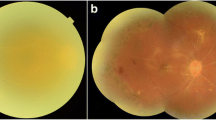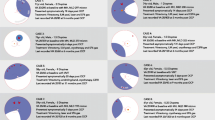Summary
Background: ARN syndrome follows severe intraocular infection by herpes viruses and primarily affects the peripheral retina. Following scar formation, despite antiviral treatment, rhegmatogenous retinal detachment occurs very often. Prophylactic argon laser photocoagulation has therefore been proposed. We report our experience.
Patients: We treated five patients presenting clinically with advanced unilateral ARN with acyclovir. All eyes received a prophylactic confluent double row of argon laser treatment (500 μm, 0.2 s, gray-white lesions) central to the affected area as soon as was possible, depending on the vitreous clouding. Four patients were treated with Aspirin.
Results: One of the five patients had a peripheral rhegmatogenous retinal detachment that was limited by the argon laser row. Another patient had a tractional detachment needing vitreoretinal surgery. Two eyes developed vitreal hemorrhage of unknown origin.
Conclusion: A lower rate of rhegmatogenous retinal detachments than expected occurred post-laser treatment. Vitreal hemorrhage was more frequent than previously reported. The bleeding probably originated from anterior retinal neovascularization and may have been enhanced by Aspirin treatment. We recommend early prophylactic argon laser photocoagulation in all ARN patients in agreement with the results of previous studies.
Zusammenfassung
Hintergrund: Das akute Retinanekrose (ARN)-Syndrom wird durch eine Infektion der peripheren Netzhaut mit Viren der Herpesgruppe verursacht. Nach narbiger Abheilung unter antiviraler Therapie treten sehr häufig rhegmatogene Amotiones auf, weshalb eine prophylaktische Argon-Laserkoagulation (ALK) empfohlen wird. Wir berichten über unsere Erfahrungen.
Patienten und Methoden: Fünf Patienten mit ausgedehnter unilateraler ARN wurden systemisch mit Aciclovir behandelt. Alle Augen erhielten eine prophylaktische ALK mit einer konfluierenden Doppelreihe (500 μm, 0,2 s, grau-weiße Herde), sobald und soweit der Einblick es ermöglichte. Vier Patienten erhielten prophylaktisch Acethylsalicylsäure.
Ergebnisse: Ein Patient entwickelte eine periphere rhegmatogene Netzhautablösung, die nicht über die ALK-Doppelreihe hinaus ging. Bei einer Patientin kam es zu einer flachen peripheren Traktionsamotio, die einen vitreoretinalen Eingriff erforderte. Bei zwei Augen kam es zu einer Glaskörperblutung. Eine Blutungsquelle war nicht erkennbar.
Schlußfolgerungen: Es traten nach prophylaktischer Laserkoagulation seltener rhegmatogene Netzhautablösungen auf als erwartet. Glaskörperblutungen waren jedoch häufiger als bisher beschrieben. Wahrscheinlich handelt es sich um Blutungen aus anterioren retinalen Neovaskularisationen, die möglicherweise durch Acethylsalicylsäure begünstigt wurden. Wir empfehlen eine frühzeitige prophylaktische ALK bei allen ARN-Patienten in Übereinstimmung mit anderen Studien.
Similar content being viewed by others
Author information
Authors and Affiliations
Rights and permissions
About this article
Cite this article
Hudde, T., Althaus, C. & Sundmacher, R. Argon laser photocoagulation to prevent rhegmatogenous retinal detachment in patients with acute retinal necrosis (ARN) syndrome. Ophthalmologe 95, 473–477 (1998). https://doi.org/10.1007/s003470050299
Published:
Issue Date:
DOI: https://doi.org/10.1007/s003470050299




